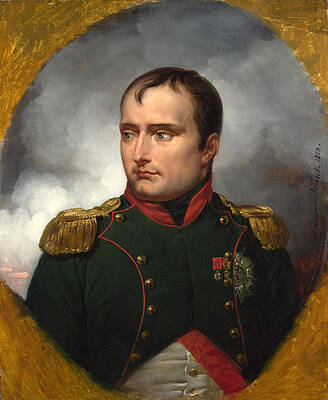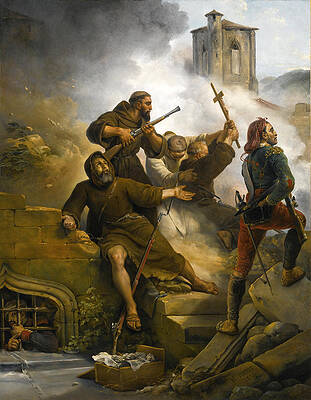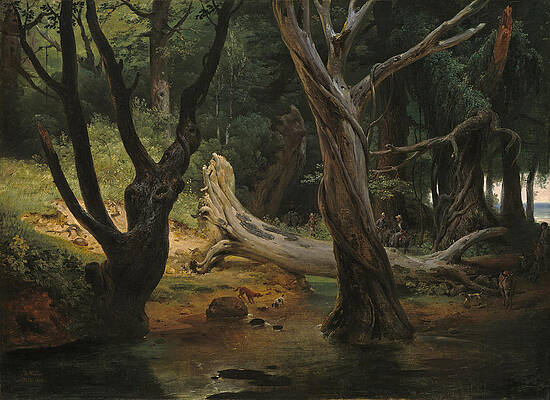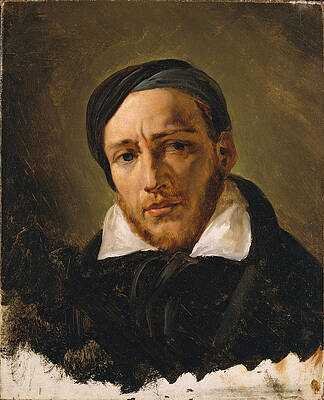Emile Jean Horace Vernet
Paintings
The Emperor Napoleon I
The Battle of Valmy
The Angel of Death
The Start of the Race of the Riderless Horses
The Maiden's Lament
The Death Angel or Death and the Maiden
Death of Prince Poniatowski on October 19th 1813
The Siege of Saragossa
The Tomb of Napoleon in Sainte-Helene or The Apotheosis of Napoleon
Death of Prince Poniatowski on October 19th 1813
The Battle of Jemappes
The Battle of Jena, 14th October 1806
The Battle of Montmirail
The Battle of Hanau
Judah and Tamar
Bertel Thorvaldsen
Italian Brigands Surprised by Papal Troops
Combat of a Greek and a Turk
Emperor Napoleon I and his Staff on Horseback
Judith and Holofernes
Departure for the Hunt in the Pontine Marshes
Self-Portrait in Rome
Napoleon at Charleroi Meditating over a Military Map
Jean-Louis-Andre-Theodore Gericault
The Triumph of Aemilius Paulus
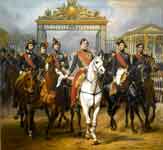
French King Louis-Philippe I (Louis Philippe) and his five sons
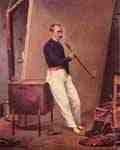

Portrait of a Lady (Possibly Mrs. Patrick Campbell, Nee Fitzgerald [1796-1869])
Fine Art Prints | Greeting Cards | Phone Cases | Lifestyle | Face Masks | Men's , Women' Apparel | Home Decor | jigsaw puzzles | Notebooks | Tapestries | ...
Émile Jean-Horace Vernet (30 June 1789 – 17 January 1863) was a French painter of battles, portraits, and Orientalist Arab subjects.
Biography
Horace vernet
Vernet was born to Carle Vernet, another famous painter, who was himself a son of Claude Joseph Vernet. He was born in the Paris Louvre, while his parents were staying there during the French Revolution. Vernet quickly developed a disdain for the high-minded seriousness of academic French art influenced by Classicism, and decided to paint subjects taken mostly from contemporary culture. Therefore, he began depicting the French soldier in a more familiar, vernacular manner rather than in an idealized, Davidian fashion. Some of his paintings that represent French soldiers in a more direct, less idealizing style, include Dog of the Regiment, Trumpeter's Horse, and Death of Poniatowski.
He gained recognition during the Bourbon Restoration for a series of battle paintings commissioned by the duc d'Orleans, the future King Louis-Philippe. Critics marvelled at the incredible speed with which he painted.[2] Many of his paintings made during this early phase of his career were "noted for their historical accuracy as well as their charged landscapes."[3] Examples of paintings in this style include the Battle of Valmy, the Battle of Jemappes, and the Battle of Montmirail.
Over the course of his long career, Horace Vernet was honoured with dozens of important commissions. King Louis-Philippe was one of his most prolific patrons.[2] His depictions of Algerian battles, such as the Capture of the Smahla and the Capture of Constantine, were well-received, as they were vivid depictions of the French army in the heat of battle. After the fall of the July Monarchy during the Revolution of 1848, Vernet discovered a new patron in Napoléon III of France. He continued to paint representations of the heroic French army during the Second Empire and maintained his commitment to representing war in an accessible and realistic way. He accompanied the French Army during the Crimean War, producing several paintings, including one of the Battle of the Alma, which was not as well received as his earlier paintings. One well known and possibly apocryphal anecdote maintains that when Vernet was asked to remove a certain obnoxious general from one of his paintings, he replied, "I am a painter of history, sire, and I will not violate the truth," hence demonstrating his fidelity to representing war truthfully.
Vernet died in his hometown of Paris in 1863.
Literary references
In Arthur Conan Doyle's Sherlock Holmes story "The Adventure of the Greek Interpreter" Holmes claims to be related to Vernet, stating, "My ancestors were country squires... my grandmother... was the sister of Vernet, the French artist.", without further clarifying whether this is Claude Joseph Vernet, Carle Vernet or Horace Vernet.
References
"Washington and Lee University". Home.wlu.edu. Retrieved 2012-06-11.
Ruutz-Rees, Janet E. (Janet Emily) (1880). Horace Vernet. New York: Scribner and Welford.
The Art of War[s]: Paintings of Heroes, Horrors and History - Chase Maenius
Further reading
Dayot, Armand (1898). Les Vernet : Joseph--Carle--Horace. Paris: A. Magnier.
Ruutz-Rees, Janet E. (Janet Emily) (1880). Horace Vernet. New York: Scribner and Welford.
----
Fine Art Prints | Greeting Cards | Phone Cases | Lifestyle | Face Masks | Men's , Women' Apparel | Home Decor | jigsaw puzzles | Notebooks | Tapestries | ...
----
Artist
A - B - C - D - E - F - G - H - I - J - K - L - M -
N - O - P - Q - R - S - T - U - V - W - X - Y - Z
Retrieved from "http://en.wikipedia.org/"
All text is available under the terms of the GNU Free Documentation License


